What’s On at The Met This Month?
7th Sept 7pm A Room of One’s Own (play) £12
9th Sept 8pm Dr Feelgood (Band) £22
15th Sept 8pm These Wicked Rivers (Band) £16
21st Sept 1pm Lunchtime Theatre – Lodging a Complaint £6 (refreshments included)
23rd Sept 7pm Play – Less For Murder £9
Every Mon 18th Sep to 18th Dec at 10.30am £4
Shiny Happy People (Parent & Toddler group)
For more information visit or Tel 01495 533195
Museum Opening Times
The Museum is open to the public, free of charge:
Thursday* to Saturday 10am – 1pm
August 100 Club
This month’s prize numbers were drawn by member Audrey Osland and the lucky winners are:-
No 24 Mary Coles £20
No 68 Lucy Harding £10
If you would like to join our 100 club and be in with a chance of winning, it costs just £1 a month. Ask at the museum for further details.
 Happy Birthday!
Happy Birthday!
Many happy returns to long-standing member Mrs Margaret Cook who has recently celebrated her 90th birthday!
New Acquisition
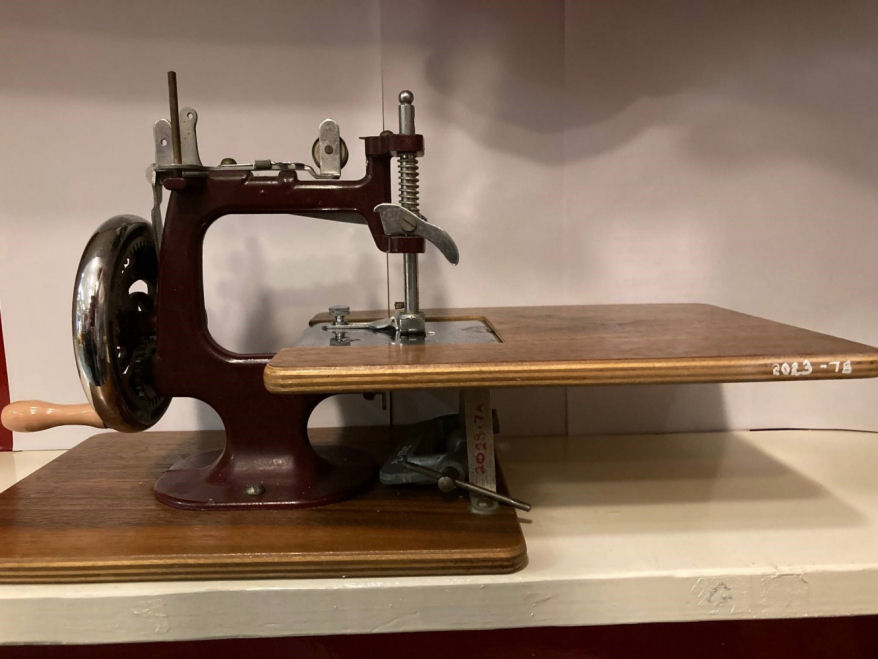
What is it about miniature that makes it so appealing? This delightful child’s sewing machine, made of wood and metal, was kindly donated by a Mrs Fowler and it measures just 22cm in length by 20cms tall and has a depth of 16cms (roughly (9 x 8 x 6 inches). Circa 1950, it was used in its day to make doll’s clothes. It is now on display in our new acquisitions display cabinet near the entrance. Take a look on your next visit.
Alexa CPR
Do you have an Amazon ‘smart speaker’ at home? If so did you know that in the event of a cardiac arrest emergency you can ask for help? Simply say ‘Alexa activate emergency CPR’ and ‘Alexa' will talk you through the procedure!
Portmeirion
Portmeirion is perhaps best known for the filming location of the cult 1960s television series The Prisoner starring Patrick McGoohan in which he plays a government agent who is kidnapped from his London home and wakes up in the most idyllic village imaginable which, in reality, is actually a prison. Chased down by giant white balls on the beach, he spends the entire series trying to escape this bizarre prison and the equally bizarre villagers.
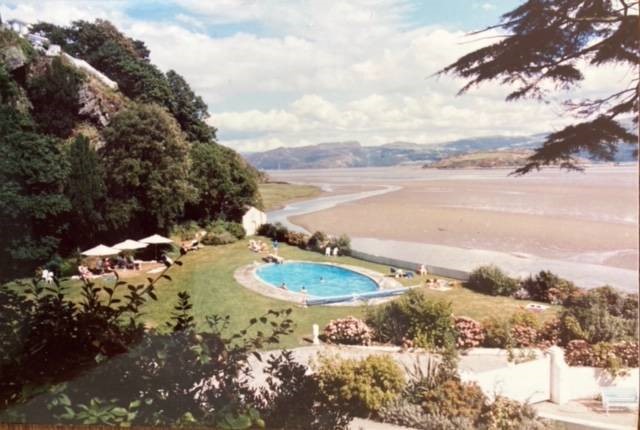
Hotel pool and beach beyond
The village, nestled above the sandy beaches of the Dwyryd Estuary in Gwynedd north Wales, was the brain-child of Sir Clough Williams-Ellis and took most of his life to build. It was started in 1926 and not completed until 1976 by which time he was well into his 90s. The village has a very Italian feel to it and some say he took his inspiration for its design on the Italian fishing village of Portofino though he always denied this.
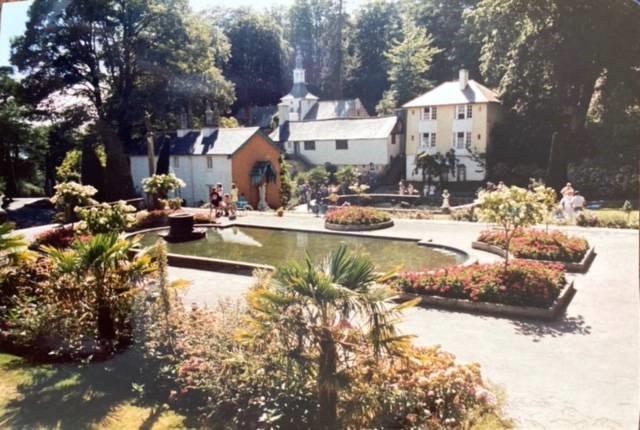
The Village Piazza
Anyone with an interest in architecture will enjoy viewing the many and varied styles from the ‘round house’ to the ‘pantheon’ (also known as ‘the green dome’) to the quirky shops in ‘Battery Square’ where, amongst other things, you will be able to buy souvenirs relating to ‘The Prisoner’. And at the heart of the village you will find the village square or ‘Piazzo’ with its beautiful water feature.
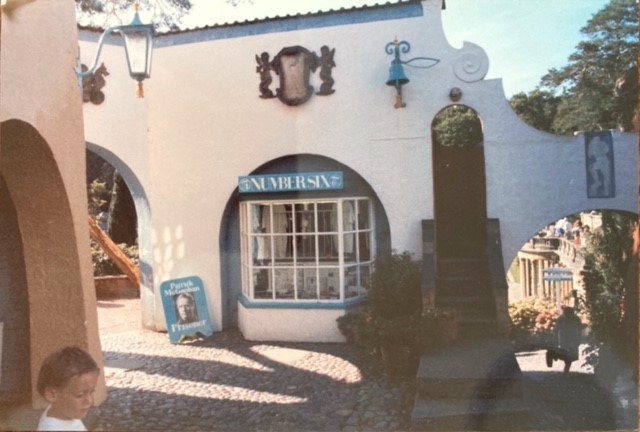
A shop in Battery Square
No-one lives in the village; the whole of Portmeirion is a dedicated tourist resort and today is owned by a charitable trust. Visitors can choose from hotel accommodation (it has two) to self-catering in one of its cottages.
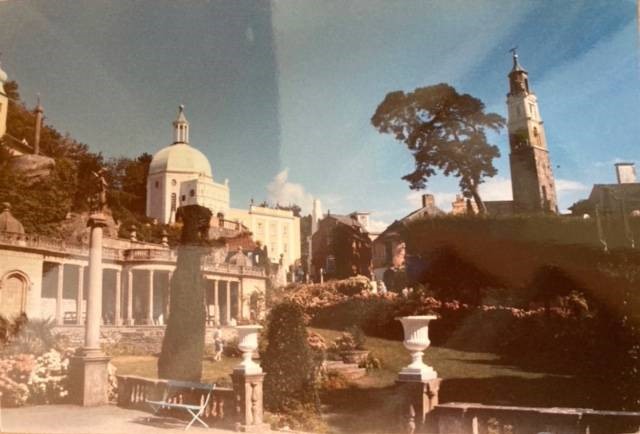
The Pantheon
No building is unused; what isn’t accommodation is used as a shop, tea-room or restaurant. It is also a very popular wedding venue. Of course you don’t have to stay here to visit; day trippers are welcome with tickets available to purchase online or at the entrance on arrival.
For more information on Portmeirion click here and here.
Sally Murphy
The Rise and Fall of Gnomes
Last year I read that garden gnomes were falling out of favour and since then I have encountered them everywhere! The cheeky chappies pictured here I spotted in my local Wilko store. It got me wondering where the craze for gnomes originated…
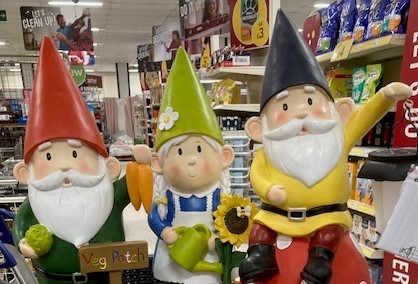
It all started in Germany in the mid 19th century where they were made in the image of dwarf-like mythical creatures said to help out in mines and on farms. It was believed they offered protection from evil and would bring good luck and prosperity. Credit for the very first models of ‘little folk’ is thought to belong to a Dresden company by the name of Baehr and Maresch who were making the ceramic figures as early as 1841.
These early ceramic gnomes all had pointed hats, beards and were usually holding something such as a fishing rod or spade and all, without exception, were male; yes there were no female gnomes at all in the 19th century.
In 1847 gardener and landowner Sir Charles Isham went on a trip to Germany and brought back 21 of them. He had intended they be used as ornaments for the table at dinner parties, perhaps as a conversation starter, but his wife was having none of it and, deeming them to be ugly, they were relegated to the garden of his house, Lamport Hall, in Northamptonshire.
Word must have spread though as by the end of the century German manufacturer’s were mass producing them with many destined for British gardens. Since the first gnomes arrived in the UK, Britons have fallen in and out of love with them. The 1914-18 war with Germany saw their popularity plummet while the 1937 Walt Disney film Snow White and the Seven Dwarfs saw their resurgence. World war two (1939-45) saw their popularity fall once more only to rise again in the 1960s while plastic gnomes flooded the market in the 1970s and 80s. And did you know that gnomes are banned from the Chelsea Flower Show? They were banned in 2006 but were allowed a brief return in 2013 for their centenary show and to raise money for charity.
Today only one of Isham’s twenty-one original gnomes survives. Nicknamed ‘Lampy’ he is on display at Lamport Hall and is said to be insured for one million pounds!
You can read more on the history of garden gnomes using this link
The Big Dipper
The Big dipper opened at Blackpool Pleasure Beach on 23rd August 1923 making it 100 years old. It is one of three rollercoasters in the UK that has Grade II listed status; the other two being at Margate and Great Yarmouth. The wooden coaster, designed and built by William Strickler and John Miller, is over 3000 feet long and reaches speeds of around 50mph. The ride lasts three minutes though the first minute is taken in the climb to the top of the first drop which is 65 feet high.
Step aboard, take your seat and watch the ride here
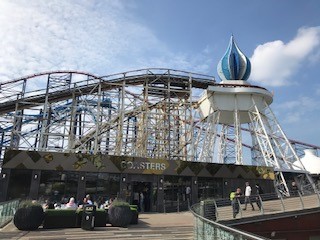
Sally Murphy
ODD JOBS
A relative of mine described his job, in the 1920s, as a 'jam boiler'. A look on Google revealed that this was one of a number of official titles for census purposes at the time and it went on to give a detailed description of what the job entailed. When I came to write up this short piece, it took some time to track it down again but here it is "weighs or measures out exact quantities of fruit, sugar, water and other ingredients (if any) according to recipe; pours ingredients, in correct sequence and at stated intervals, into steam or gas-heated coppers; usually attends from six to ten coppers and regulates heat by controlling steam valves, gas Jets, etc.; stirs contents of coppers, either by hand or by switching on mechanical stirrers; runs off jam, etc. into large receptacles, when correct consistency has been reached; sometimes also does work of fruit jelly maker". It's a very complicated description and you have to wonder why it was deemed necessary to define the job so precisely. It was job code 436.
If you were a fisherman you fell into just one category – job code 000. It didn't seem to matter whether you were an inshore or deep sea fisherman, what type of fish you caught or your rank. Compare that with agriculture which comprised no less than 29 different types of job such as farmers, labourers, gardener's labourers and pea and fruit pickers. In 1921 there were 32 broad categories of workers within which were no less than 999 job codes with number 1000 being "Other Persons (not Retired and not Gainfully Occupied). "
Most of my ancestors were miners/colliers although there was also a basket maker, a stocking maker, an ostler (someone employed to look after horses at an Inn) and a servant among others. The most upsetting was to come across a census entry for a very young ancestor of mine whose job was a door boy in a pit – what a terrifying thing for a child to have to do, sitting in the depths of a mine in the dark for hours on end! You may well have someone in your family who did something unusual - it's surprising what you can find when you start delving into old records although it can be very time-consuming and very frustrating when you hit a dead end. It helps to have an unusual name. Thomas, one of my family names, isn't the easiest name to track down in Wales.
Anyway, I think there must be a bit of jam boiler in me as each summer I make jam with my surplus fruit from the allotment. Is it in the genes I wonder?
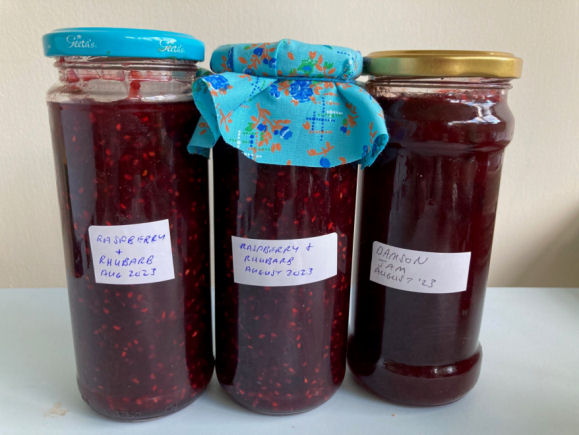
Jen Price
National Treasure
A wooden comb thought to date from around 1200 BC has been dug up in a field near St Nicholas and Bonvilston in the Vale of Glamorgan. The comb, along with four other ancient artefacts; a gold ring, an iron sword, a silver crossbow brooch and a bronze spearhead circa 1000 BC have all been declared National Treasure by the coroner for south Wales. The artefacts will all be going on display at the National Museum of Wales and you can read more on the story using this link
Top Of Page
© Abertillery & District Museum 2023 
